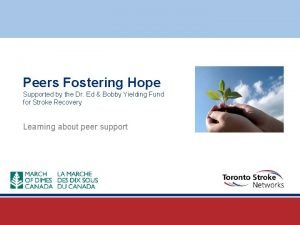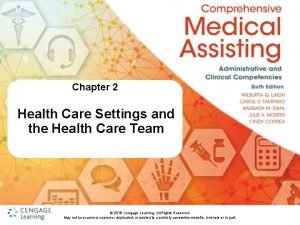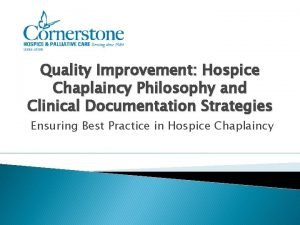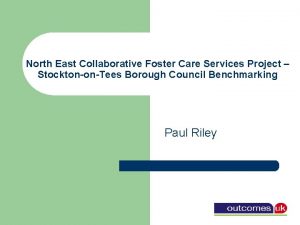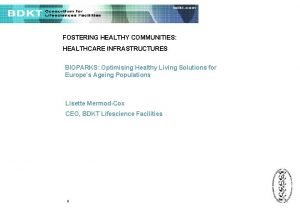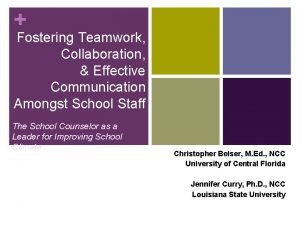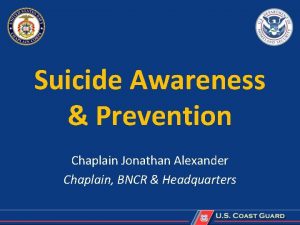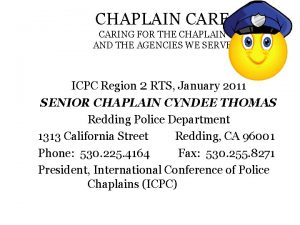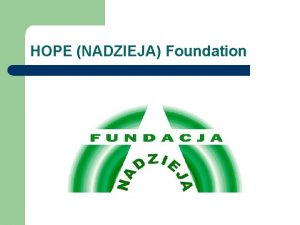1 Title Fostering Hope The Christian Healthcare Chaplain















- Slides: 15

1 Title: Fostering Hope: The Christian Healthcare Chaplain in a Caring Relationship Presented By: Felix O. Otuorimuo Mentor: Dr. Harold D. Bryant

2 Abstract: In 2017, data showed an increasing rate of 10. 6 million persons between the ages 18 -65 that have had suicidal thoughts. The Christian Healthcare Chaplain(CHC) to act as first line of contact to provide spiritual care intervention, which my Masters thesis revealed.

3 Respondents from 35 online surveys revealed the importance of CHC fostering biblical hope for recovery, repair and restoration. The interest to expand this research at doctoral level on fostering biblical hope and developing H. O. P. E Tools will achieve greater result to mitigate against suicidal thoughts.

4 Purpose Statement: The study seeks to understand how the Christian healthcare chaplain in a caring relationship, fosters biblical hope as spiritual care intervention to persons with suicidal thoughts to promote recovery, repair and restoration

5 Methodology: The methodology is a qualitative research. The study used purposeful sampling, with focus on CHCs in a pluralistic chaplains’ ministry. The population are 18 -65 years of age, serving in a hospital, or military personnel who have served in a hospital facility.

6 Research Questions: Is the CHC invited as a first-line of contact to provide spiritual care to a person with suicidal thoughts? Do CHC conduct spiritual assessment of a person with suicidal thoughts to foster biblical hope?

7 Research Questions: How the CHC fosters biblical hope as spiritual care intervention to persons with suicidal thoughts to choose life? How the CHC demonstrates a caring attitude to establish trust with a person having suicidal thoughts to create an atmosphere of trust.

8 Research Finding: CHCs are occasionally invited as first line of contact to provide spiritually care to persons with suicidal thoughts.

9 Research Finding: The importance of spiritual assessment to determine the faith, religious belief, community, and addressing stressors which allows the CHC to foster biblical hope in the patient to choose to live.

10 Research Finding: The importance of fostering biblical hope as God’s spiritual care of healing a person with suicidal thoughts to promote personal wellbeing.

11 Research Finding: The Chaplain’s caring attitude creates trust and willingness of the person with suicidal thoughts to choose life and avoid the act of killing themselves.

12 Research Finding: The importance of spiritual counsel, prayer, bible reading and meditation to nurture hope to prevent suicidal thought.

13 Christian Worldview Integration: The integration of biblical hope presents a strong defense for the origin of hope, a virtue for spiritual crisis intervention to mitigate against suicidal thoughts. For example, the widow of Zarephath had suicidal thoughts, a decision to kill herself and her son after eating their only meal (1 Kings 17: 12).

14 Conclusion: My research is impactful to reduce the national crisis on suicidal thoughts and prevent persons from the plan to kill themselves. The integration of biblical hope is a spiritual crisis intervention model to achieve individuals and the family wellness, improve the health of the community and increase the level of participation in socio-economic activities.

Bibliography: Bauckham, Richard. Jurgen Moltmann: Collected Readings. Edited by Margaret Kohl. Minneapolis, MN: Fortress Press, 2014. Carrigan, R. L. “Where has hope gone? Toward an Understanding of Hope in Pastoral Care. ” Pastoral Psychology 25, no. 1 (1976): 39 -52. Accessed 24, 2018. https: //www. digitalcommons. liberty. edu/pastoral/vol 25/iss 1/. O’Brien, Elizabeth Mary. Spirituality in Nursing: Standing on Holy Ground. Burlington, MA: Jones and Bartlett Learning, 2014. Suicide Prevention Resource Center. Suicide Thoughts and Behavior in the Past Year Among Adults, United States 18 Years and Above, National Survey on Drug Use and Health, (2017). Accessed April 28, 2018. https: //www. sprc. org/scope/attempts/. Suicide Prevention Resource Center. Percentage of High School Students Reporting Suicide Behavior, United States (Past 12 Months), Youth Risk Behavior Surveillance System, (2017). Accessed April 28, 2018, https: //www. sprc. org/scope/attempts/. Villatte, Jennifer L, Stephen S. O’Connor, Rebecca Leitner, Amanda H. Kerbat, Lora L. Johnson and Peter M. Gutierrez. “Suicide Attempt Characteristics Among Veterans and Active-Duty Service Members Receiving Mental Health Services: A Pooled Data Analysis. ” Mil Behav Health 3 no. 4 (Sept 2015): 1 -21. Accessed April 24, 2018. https: //www. ncbi. nlm. nih. gov/pmc/article. 15
 Fostering hope scholarship
Fostering hope scholarship Sports medicine meaning
Sports medicine meaning Healthcare and the healthcare team chapter 2
Healthcare and the healthcare team chapter 2 Hospice chaplain documentation examples
Hospice chaplain documentation examples Chaplain center and school
Chaplain center and school Ffa officers and symbols
Ffa officers and symbols Ffa historian duties
Ffa historian duties Boy scout chaplain aide prayers
Boy scout chaplain aide prayers What is a sports chaplain
What is a sports chaplain Fostering in doncaster
Fostering in doncaster Fostering stockton on tees
Fostering stockton on tees Fostering healthy solutions
Fostering healthy solutions Fostering teamwork and collaboration
Fostering teamwork and collaboration Creativity and play fostering creativity
Creativity and play fostering creativity Title fly of a report
Title fly of a report Title title
Title title
